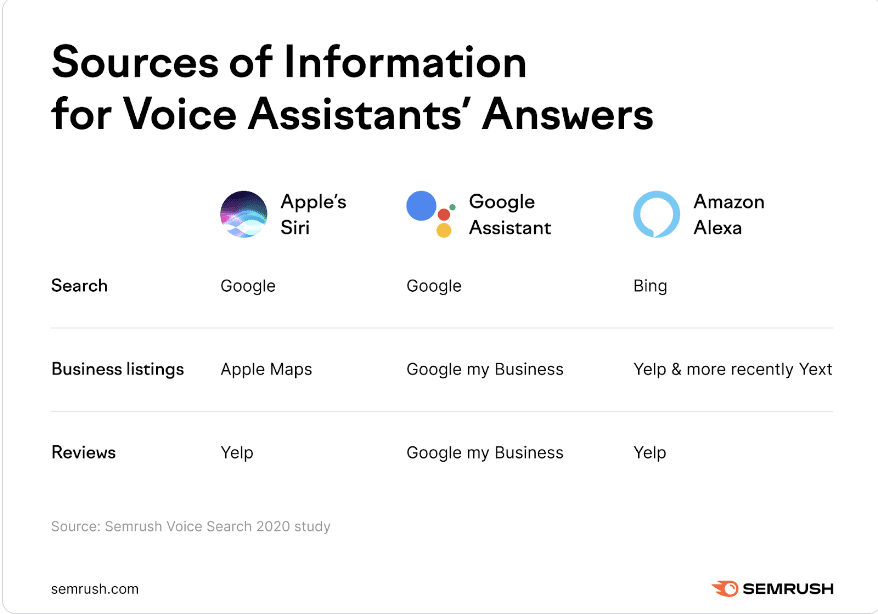Hey Siri, how much has voice assistant usage grown in the past few years?
Having a personal assistant ready to respond quickly is convenient for all your tasks, from texting your best friend to setting timers. It allows you to multi-task or receive answers to questions without having to pick up your phone and interrupt what you’re doing.
Are you in the middle of a board game and want to know when the game came out? Just ask Google Assistant. Are you exercising and curious how many calories 30 minutes on a treadmill burns? Ask Siri.
The convenience of voice assistance is beginning to impact SEO directly. The very foundation of SEO starts with targeting search phrases people use. But if people use voice assistants to search and consume content, how might SEO look different due to changing search phrases?
Here are a few predictions for voice search SEO based on trends we already see and what we know about content consumption from our years of content marketing experience.
The Growth of Voice Search
Voice assistants have come and gone (goodbye, Cortana). Today, three contestants stand as the most popular voice assistants:
- Google Assistant
- Apple’s Siri
- Amazon’s Alexa
You will also come across lesser-known or more niche voice assistants built for individual brands or apps.
Voice assistants are everywhere, helping people live more device hands-free without losing their connection to limitless information.
In 2024, there were nearly 149.1 million voice assistant users in the US alone. That number is expected to grow to 162.7 million by 2027. This number includes voice assistants on smartphones, smart TVs, connected cars, and smart speakers.

How Voice Search Impacts SEO
About 45% of Americans use voice assistants for information discovery. Whenever someone asks their voice assistant a question, it pulls that information directly from the web and reads it back to the user.
On smartphones, voice assistants often offer links so users can read the topic further (Yay web traffic!).
This rise in voice assistants will impact SEO content marketing because people search for information on Google and consume the content from search results pages, whether knowingly or not.
When people search through a voice assistant, they begin with a question. That’s different from most typed searches that often use scattered or disjointed phrases.
For example, if you want to know how to fix a leak in your bathroom sink, you might type “bathroom sink leak” or “how to fix bathroom sink leak.” However, when you talk to a voice assistant, you ask complete questions using your natural language patterns, like “Hey Alexa, how do you fix a leak in your bathroom sink?”
The voice assistant pulls the answer directly from a search engine like Google. Most responses come directly from a web source, with only a few pre-programmed responses, like when you ask Siri to tell you a joke.
Search queries will also subtly change with the increased use of voice search and how people consume those answers. Rather than only reading results, more people will use voice assistants to read out results or sections of your content.
Is your content optimized for voice assistants pulling out quick answers?
5 Steps Marketers Can Take When Performing Voice Search SEO
Use these five steps to help you create high-ranking content and optimize for voice search.
1. Target Long-Tail Keywords
You rarely hear someone talk to their Google assistant using half-baked sentences. Your voice search audience is often using complete sentences and very specific questions.
That’s good news for you because those specific questions are often far less competitive SEO keywords than the one or two-word keywords.
You’ll find most of those questions through your SEO tools or in Google’s People Also Ask section. In SEMrush, you can see a breakdown of keywords into groups that include keyword ideas and questions.
Mixing in those long-tail keywords helps you gain that voice assistant traffic. You can use them as either blog post titles or supporting keywords throughout your content and website.

2. Focus on Natural Language in Your Content
As you write your content, especially when targeting long-tail keywords that will attract voice assistants, consider how your content will sound read aloud.
You always have a chance of someone reading your content aloud, which should be a constant consideration. Reading your content aloud during editing is a good rule, but it is almost essential when optimizing for a voice assistant.
You will want your content to flow easily and sound natural. Try to aim for a conversational style that is engaging to read but still offers value with every sentence. If your sentence is too convoluted that a reader needs to see it on paper to understand its meaning, it’s probably not a good fit for voice assistant responses.
You will also want to be conscious of periods and paragraph breaks. This signals the voice assistant, just like it does for a reader, to take a breath so your content doesn’t sound like a long-winded speaker.
3. Take Advantage of Text to Voice
Voice assistants do more than just read words on a page. They can interpret everything going on with your content.
This is especially important to keep in mind when researching how to optimize a website for voice search as you will need users to be able to navigate pages using voice assistants, not just read straight text.
Think back to the last time you watched a movie with subtitles. Remember how the subtitles didn’t just transcribe conversations. It also transcribed sounds like horse hooves, wind, and the actor’s sighs.
Voice assistants act similarly. They don’t just tell people what words say. They can also scan and describe specific images, buttons, or even videos.
Since smart technology is often anything but smart, you don’t want to leave media descriptions up to chance. Instead, optimize your alt-text. This is a good habit for accommodating voice assistants and aiding those using text-to-speech or whose images won’t load.
When you optimize your alt-text, describe the image clearly yet succinctly. You may also add a keyword in your descriptions to help with SEO, both from voice assistants and traditional SEO.
4. Create Snippet-Worthy Responses
If you ask your voice assistant who the third king of England was, it most likely will not read the entire Wikipedia article that appears at the top of your search results pages. It will pull just the most crucial information and provide a quick response, such as “The third king of England was Edward III.”
The average voice assistant response uses 29 words to answer your questions fully. That is the exact length of the paragraph you are reading now, which isn’t very long.
Voice search and SEO strategies you already use go hand-in-hand. As you create your content, write with those short snippets in mind. About 40.7% of voice assistant responses are pulled from Google snippets, so optimizing for short snippets is a win-win for traditional and voice-centered SEO.
When creating snippet-worthy content, a good rule is to have one or two separate sentences under each main heading, especially question headings, answering the question in a quick, clear response. This snippet is convenient for voice assistants to respond to any voice-generated queries.
5. Optimize Voice Assistant Sources
Up until now, we have only talked about Google search results pages when discussing how to optimize for voice search. That is because it is the most popular search engine for voice assistants. However, it’s not the only source that might pop up in voice assistant searches.
While Apple and Google products pull from Google, Amazon’s Alexa uses Bing. In addition, voice assistants will also pull listings from Maps, Google My Business, and Yelp.
Making sure you optimize those key sources puts you at an advantage in voice assistant searches.
Next time someone is driving and asks where a laptop repair shop is near them, your business could show up, as long as you are listing it in the prime spots that voice assistants pull from.

Prepare Your Content for Voice Search SEO
Has your latest content strategy included voice searches?
You will want to tap into those millions of monthly searches by optimizing for voice assistants. With the right strategy in place, you can equally target those who find your content on computers, smartphones, tablets, and voice assistants.
Learn more about our content strategy services and how we can help adjust your strategy for SEO voice search.
